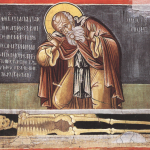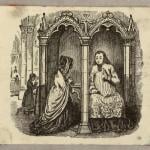
Nature in Paul’s writings, or rather the Greek word we translate as nature, probably doesn’t mean what you think it means.
Many times I have repeated here on this blog that whenever 21st century people read Paul, spurious familiarity is a constant problem. We think we know Paul and understand him like an old friend, but do we really? Today’s Christians tend to think he’s like an old shoe or glove, fitting nice and comfortably over our Christian theological expectations. But the real Paul is shocking, folks, and unfamiliar to most. This is put on display when we consider how Paul views “nature.”
What do you think about when you see the words “nature” or “natural”? Whatever it is, chances are that Paul has something very different in mind when he writes the Greek word physeis. Our English translators render physeis into “nature.” When Paul writes para physein, it get’s translated into “contrary to nature.” And his expression kata physein gets translated “in accordance with nature.” We tend to dip our English Bible translations into the chocolate of our own culturally familiar meanings, whether from philosophy (as in “natural law”) or science. But is any of this what Paul really had in mind?
Paul, “Nature,” Olives, and Mangoes
It might be helpful to contrast our socially familiar meanings with how Paul really wrote about “nature.” For example, when Israelite males wear their hair long, Paul says that is para physein (1 Corinthians 11:5-16). So, is it really against nature for men not to have short hair? Is that against Natural Law? Really? How interesting!
And when first century non-Israelites joined the Jesus group, Paul likewise commented that this rarity he tolerated was para physein (Romans 11:13-24)—like taking a wild olive branch and grafting it onto a cultivated olive tree. You may not know it, but Paul comes from a very different world than ours where the majority of people were producers, not just consumers. His world was agrarian. Back then, almost everyone was familiar with the proper (kata physein) grafting practice: take a cultivated branch and graft it onto a wild olive tree. Watch the video below…
To make sense of that, consider the following. I come from a place where mangoes grow abundantly. The same grafting rule applies. Say I own a Haden mango tree (delicious!) and I graft onto it a Kent mango (also delicious) branch. Then that means that I am going to get two different varieties of tasty, edible fruit every year, at harvest. Paul would agree that doing grafting that way would be kata physein.
Paul Tolerated Gentile Believers
But imagine instead that I did something similar to Paul’s analogy in Romans 11:24 and grafted a turpentine mango branch onto a Haden mango tree. What would result? Fruit produced from such a bizarre graft would be nauseating and inedible. Following Paul’s analogy, such a mango graft would be para physein.
What goes for mangoes, also applies to olives and pretty much all grafted produce. In the only place in his seven authentic letters where Paul addresses non-Israelites, he roundly insults them, saying their graft is para physein. Wow. And all us Gentile believers say, “Thank you, Paul!”
According to Bruce Malina, in the Hellenistic period Israelites considered mixed Gentile marriages as “offering one’s children to Molech” (Leviticus 18:21; 20:2). Because such “abhorrent unions” were considered para physein (“contrary to nature”), any Israelites engaging in them deserved the death penalty! Note how Paul assesses the offspring of a Jesus group member with an outsider (1 Corinthians 7:14). That should give you a taste of the quality of Paul’s ongoing concern with Israelite purity laws.
Imagine if we brought Paul, via a time machine, to a Billy Graham Crusade or to a World Youth Day event. With Israelites nowhere to be found, Paul would look around baffled that Israelite Theocracy had refused to materialize almost 2,000 years following his death. But he would also be shocked at seeing the Body of Christ gathered at these events and conclude that the whole thing was para physein!
Contrary to Nature & Surprising Symbolism
I can think of at least one other thing Paul calls para physein in his letters. Can you? Take a guess. I will have to write a post about that some time. Doing that, maybe we might just discover a new symbol for what the relationship between Christ and the Gentile Church is like. Here’s a hint: if a fitting image for Messiah Jesus and the Israelite Jesus groups is that “kata physein” union between a man and a woman, then what kind of union would symbolize Christ and the Gentile believers?
To quote George Takei…
Nature = Custom
For Paul, women have long hair, and men have short hair, and such practices are kata physein, translated “in accordance with nature.” In other words, kata physein really means in accord with Israelite custom.
Therefore, physein (translated as “nature”) = custom. Specifically, first century Israelite custom.
Language, you see, only means what it means where and when you use it. That applies to “nature” as well. Whenever you move the language, you can’t escape changing it’s meaning. And we Western 21st century Bible readers have serious problems when reading Paul, one of which is language availability. To see what I mean, watch the following video about what Paul means by “your body”…
How Paul Figured What is “Natural”
So “nature” to Paul really means Israelite custom. But who made the custom, Paul? Must have been the God of Israel. And how does Paul know that? Well, it’s a safe bet that Paul wore his own hair short. Why? It was because his father and all of the collectivistic, dyadic personality village males in Gischala (where he was born) also had short hair. They all shared a group-self and group-conscience (they were collectivists) and were not American individualists, I’m afraid.
And then, after he and his family were sold as slaves to Tarsus, there they found the same hairstyles also. Before that, Paul’s grandfather had short hair as well. And that’s as far back as Paul, or anyone in his family or his village, could remember.
Therefore, Paul understands that it must have always been kata physein for all males to have that same properly short hairstyle anywhere and any time. This must have been so all the way back to Adam. God established the custom. God, with wisdom, had ordained short hair for all males from the beginning. Amen.
Natural Forever and Ever?
But unlike Paul, we know that hairstyles change, don’t they? Paul apparently never saw the kuroi statues of ca. 500 BCE. Had he done so, Paul would have believed these long-haired male figures were transsexual boy prostitutes. And Paul would find such statues disgraceful.
Paul would react in the same way were he to time-travel 500 years into his future and lay eyes on icons of Jesus where the Lord is depicted as having long hair. The hairstyles again changed! For Paul, such images and customs are para physein, against custom, what we translate as “contrary to nature.”
“But I thought Paul was the Apostle to the Gentiles!” Spiritually, in a way he could never have anticipated, Paul turned out to be that. But it’s like the old story retold by John Pilch and Anthony de Mello, the one about the family that cuts the roast in half before putting it in the oven. A guest eating dinner with the family asks, “Why do you always cut the roast in half?” And they answer the questioner, “Because we’ve always done it that way. That’s the way Great-Grandma did it. It’s better that way!” And one day, they discover the old family cookbook, and the recipe for the family roast. In the margins, someone, now long dead, scribbled: “Don’t have a pan big enough. Cut the roast in half.”












